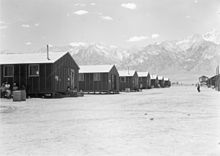Manzanar History From Wikipedia, the free encyclopedia
 After the December 7, 1941, attack on Pearl Harbor, the United States Government swiftly moved to begin solving the “Japanese Problem” on the West Coast of the United States.[43] In the evening hours of that same day, the Federal Bureau of Investigation (FBI) arrested selected “enemy” aliens, including 2,192 who were of Japanese descent.[44] The California government pressed for action by the national government, as many citizens were alarmed about potential activities by people of Japanese descent.
On February 19, 1942, President Franklin D. Roosevelt signed Executive Order 9066, which authorized the Secretary of War to designate military commanders to prescribe military areas and to exclude “any or all persons” from such areas. The order also authorized the construction of what would later be called “relocation centers” by the War Relocation Authority (WRA) to house those who were to be excluded.[45] This order resulted in the forced relocation of over 120,000 Japanese Americans, two-thirds of whom were native-bornAmerican citizens. The rest had been prevented from becoming citizens by federal law.[46][47] Over 110,000 were imprisoned in the ten concentration camps located far inland and away from the coast.[44] Manzanar was the first of the ten concentration camps to be established.[48] Initially, it was a temporary “reception center”, known as theOwens Valley Reception Center from March 21, 1942, to May 31, 1942.[48] At that time, it was operated by the US Army's Wartime Civilian Control Administration (WCCA).[49] The Owens Valley Reception Center was transferred to the WRA on June 1, 1942, and officially became the "Manzanar War Relocation Center." The first Japanese American prisoners to arrive at Manzanar were volunteers who helped build the camp. By mid–April up to 1,000 Japanese Americans were arriving daily, and by July the population of the camp neared 10,000.[50] Over 90% of the prisoners were from the Los Angeles area, with the rest coming from Stockton, California; and Bainbridge Island, Washington.[50] Many were farmers and fishermen. Manzanar held 10,046 prisoners at its peak, and a total of 11,070 people were imprisoned there.[7]
|
|